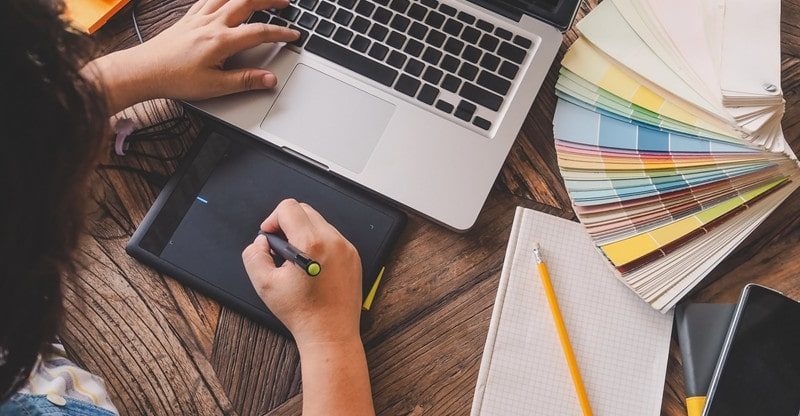How to Become a Graphic Designer with No Experience
Many visual artists and designers are attracted to the field of graphic design as it offers both creative satisfaction and greater financial security than many other artistic pathways.
Graphic designers are tasked with creating visual concepts, brand and logo design, webpages, brochures, magazines, etc. They may work in-house for an agency or as a freelance graphic designer. Graphic designers think through images and find the visual stories and motifs that best suit the client they are working with.
Although there is no formal route to becoming a graphic designer, a keen eye for visual detail and a strong creative flair are musts. Knowing how to operate and use certain equipment and software is also crucial to success. Starting out can be tough, but once you have the contacts and the experience, graphic design is a rewarding and well-paid career.
In this article, we are going to take a look at how to get started as a graphic designer with no experience and build yourself into the professional that your clients need.
How to become a graphic designer with no experience
Becoming a graphic designer with no experience requires patience, hard work, and a small bit of investment. You will need to learn your craft as you figure out the industry and find your niche.
When you are starting out, it is okay to not earn a full living from your design work and you may need to keep another job on the side. As you learn more about the industry and professionalise your practice you can pick up freelance graphic design jobs that will pay you and provide you with key experience to progress you in your career.
So let’s jump in and take a look at what to do if you are looking to become a graphic designer with no experience.
Invest in good equipment
Every graphic designer needs to be equipped with the best possible equipment they can afford. As with other digital arts, a professional graphic designer is in competition with others who have state-of-the-art kit and software. So it is important that you invest a bit into your work so that you are able to compete on a level with other designers.
As a budding graphic designer you will need:
• A high-end laptop. The debate rages on about Apple vs PC and which is better for the creative industries. Ultimately, it comes down to your own personal preference. But you should be sure that your laptop has the latest software so that it works with any updates that you will download for your creative applications.
• A high-resolution monitor. When you’re working from home (as many graphic designers often do) it is important that you have a high-resolution monitor that allows you to see your designs as clearly as possible. A high-resolution monitor will be able to show you detailed colour grading and pixilation, as well as presenting a much clearer and crisper image.
• Design tablet and stylus. The easel and brush for any graphic designer is their design tablet and stylus. This is how most of the initial design work is done and the tablet is a bridge between material art and digital art, so it is wise to invest in a good one.
• Creative design software. Again, there are many debates to be had as to which editing programmes to download. The industry standard for most creative professionals is Adobe Creative Cloud (CC). This is a collective package that comes with picture editing, video editing, as well as other digital editing and design programmes.
Of course, you can also opt to pay for the software separately if you don’t want all the programmes included in the full package. Whatever your preference of software is, make sure that it is up to date, as the industry will move with the evolution of the applications and software.
• A good camera. Not all graphic designers will tell you that you need a camera to be successful in your design career. However, having a keen eye for photography is a great way to sharpen your graphic design skills, enhance your visual art skillset, and broaden the possibilities for your design projects.
Volunteer or intern
As with many disciplines, one of the best ways of learning about graphic design as both a practice and a profession is on the job. However, this often presents a Catch 22 situation in which it is hard to get a job without having the requisite experience.
You can overcome this hurdle by offering your graphic design services on a voluntary basis whilst you learn the ropes. Although this may not be possible for everyone due to time or financial constraints, a voluntary or intern position does not have to be held full time. It is perfectly possible to gather a good amount of experience through such a position whilst only doing it one or two days a week.
If you’re still learning the ropes but are looking to send some feelers out, you can go online to find expertly curated templates for CVs and cover letters.
Do a course
You don’t have to have a Graphic Design degree or a qualification in Art and Design to be a successful graphic designer. However, it can be a good idea to do online courses or maybe an evening class in which you are taught the basics of how to use certain software and equipment, how to navigate the market and find work, and in which you are also given assistance on developing your portfolio that can then be used to get you more work in the future.
Much of what you might learn on a course can be self-taught, but a course will formalise and structure your learning. It may also offer you certification upon completion and introduce you to a network of other graphic designers looking to kickstart their careers. A course can also be a great place to try out a number of different styles or techniques that will allow you to best explore your practice with no pressure from clients.
Freelance
When you are starting out as a graphic designer, a great way to boost your CV and gain experience is to do freelance jobs on the side. The pay may not be great at first, but doing small side-hustle jobs can be the best way to learn about the ins and outs of a profession and of the market available for it.
Freelancing on the side is also a good way to start as you don’t have to rely on it for income. Instead, you can begin by dedicating one day a week or maybe a couple of evenings every week to working on your graphic design projects whilst figuring out if it is a world that you want to enter into. You can check out The Confident Freelancer for more information.
Figure out a sensible day rate
If you are going to begin your career as a graphic designer as a freelance side hustle, you need to work out how much you can charge that will ensure your pursuit is financially viable and that you are likely to get work.
If you then decide to take the plunge into full-time freelance work, be sure to have your finances figured out beforehand. The average day rate for graphic designers in the UK is £200 to £400. However, when you are just starting out, it is likely to be lower than this.
If you want to work as a full-time freelancer, the best way to work out your day rate is to set yourself a target of how much you want to earn in a year. You should then add 30% of that target to account for sick days and holiday pay etc. And then divide that figure by 220, which is the number of days you are likely to work in a year.
So if you wanted to earn £50,000 in a year:
- Find 30% of 50,000, which is 15,000.
- Add the two together, to bring you to 65,000.
- Divide 65,000 by 220, which gives you around £295.
So, to earn £50,000 a year as a freelancer, you should aim to charge around £295 per day.
Market yourself
Whether you want to work freelance or get a full-time job at an agency, knowing how to present your work well will always get you ahead of competitors. So once you have the requisite experience, it is important to know how to market yourself.
You should build a website that has contact information, work history, and an online portfolio of your best work covering as much range as possible. The website should be professional but also characterful. Try to convey a sense of who you are as well as just how good your work is.
If you don’t feel ready to build your own website, then begin by setting up professional profiles on freelancing sites like UpWork, PeoplePerHour, or Fiverr.
You might also consider designing some business cards. If you do, make sure that they are visually linked to your online presence. This will suggest that you understand branding and the importance of visual motifs.



